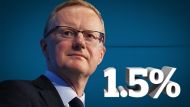The dollar's potential loss of its status as a high-yielding currency could cause the Aussie to plunge to US62¢, forcing the Reserve Bank to raise interest rates despite still-weak domestic growth, according to one of Asia's most prominent currency strategists.
Australia has historically had to offer higher interest rates to attract foreign capital into the country. But the country's yield advantage is disappearing. The yield differential between 10-year US and Australian government bonds has shrunk to less than 30 basis points, the tightest in about 15 years, as the US engages in monetary tightening while the RBA appears set to keep rates steady at 1.5 per cent.
More BusinessDay Videos
RBA housing pushback doomed to fail
Thanks to government failure, the regulators are left with inferior options for their attempt to cool the Sydney and Melbourne housing markets. Michael Pascoe comments.
The weak consumer economy makes it difficult for the RBA to raise interest rates. But this makes Australia less attractive as a location for investment, weakening the demand for the Aussie dollar.
This should be a serious concern for Australian policymakers, TD Securities' chief Asia-Pacific macro strategist Annette Beacher told The Australian Financial Review, as many foreign investors are primarily attracted to the high-yield status of the local currency.

"We're spending a bit too much time saying inflation isn't high, therefore the RBA doesn't need to hike. We all know the RBA wants a lower currency. But you have to be careful what you wish for.
"If the Fed hikes three or four times, and the RBA sits tight, we won't be high-yield. That doesn't mean the Aussie falls to US72¢. It means it collapses to US62¢. And think of the inflation shock that would cause."
Tuesday's inflation figures triggered a sustained sell-off of the Aussie dollar that only gathered steam overnight as global traders digested the figures. After dropping as much as a cent on Wednesday night to a three-month low of US74.55¢, the Aussie recovered through Thursday to fetch US74.86¢ in afternoon trade.
The first quarter's 0.5 per cent quarterly inflation figure took annual inflation to 2.1 per cent, just within the RBA's 2 to 3 per cent target band.

But the inflation figures were slightly weaker than economists' expectations. Ms Beacher said some traders were after "an excuse", with many viewing the dollar as too high given the lowering interest rate differential.
"I'm not convinced the [Reserve Bank] is looking solely at inflation," she said. "We need higher interest rates compared to the rest of the world."
"I think the Fed will continue to hike, economy will gain traction, and US treasury yields will rise, and Australia will have to work harder to attract offshore capital."
JP Morgan chief economist Sally Auld, who heads up the investment bank's fixed income and foreign exchange strategies in Australia, said she isn't as confident interest differentials will drive the Aussie's movement.
"That's the way it's meant to work," said Ms Auld of the interest rate differential theory. "But if you were to draw a chart of rate differentials between Australia and US, the relationship has completely broken down.
"You'd think with the Fed hiking that should be bearish for the Aussie, but it hasn't played out that way."
The Aussie has been very difficult to gauge this year. Historically tied to the iron ore price and strongly influenced by interest rate differentials with the United States, it has stubbornly refused to move outside a set band.
"It's been remarkably range-bound," Ms Auld said. "Since the end of 2015 it's traded in the US70¢ to US78¢ range. There's not been a lot of volatility for a currency that's regarded as one of the more out-there ones."
The Australian dollar is Asia's second-most traded, behind the Japanese yen. While the yen is viewed as a defensive bet, the Aussie is viewed as a risky currency. The country's high exposure to China, through iron ore, means the unit is correlated with movements in the iron ore price.
But this relationship failed to play out in the early part of this year. While iron ore surged to $US90 a tonne, the dollar saw some strength, but failed to break past US78¢. In the past month iron ore has lost a third of its price, but the Australian dollar has barely moved.
Ms Auld speculates this could be because commodity prices are no longer having the stimulatory impact they used to on the Australian economy. Australia's big miners are majority foreign-owned, so any boosted dividends largely flow directly offshore. In the absence of a mining investment boom, the impact on the real economy has been minimal. Inflation rates have remained very low or gone backwards, in the case of discretionary sectors like categories like retail and recreation, despite record-low interest rates.
Ms Beacher said the commodity price movements were complicating the dollar's recent movements. Coal, copper and gold prices remain high. While iron ore is dropping, it isn't Australia's only export.
"For a long time it was cheap compared to commodities and expensive compared to interest rates," said Ms Beacher. "It's still expensive on interest rate differentials. It doesn't matter what spread you look at, the Australian is lofty on that front.















